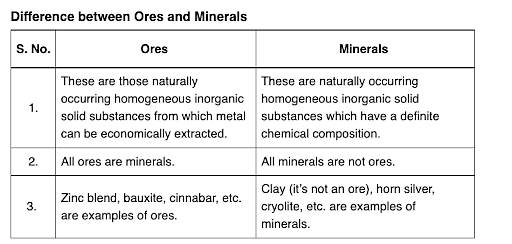Question:
Which one of the following is a mineral of iron?
Which one of the following is a mineral of iron?
Updated On: May 4, 2024
- Malachite
- Cassiterite
- Pyrolusite
- Magnetite
Hide Solution
Verified By Collegedunia
The Correct Option is D
Solution and Explanation
$Fe _{3} O _{4}$
Was this answer helpful?
0
0
Top Questions on General Principles and Processes of Isolation of Elements
- In the extraction of iron using blast furnace to remove the impurity (X), chemical (Y) is added to the ore. X and Y are respectively
- TS EAMCET - 2025
- Chemistry
- General Principles and Processes of Isolation of Elements
- What is used for the Thermite Reaction?
- BCECE - 2025
- Chemistry
- General Principles and Processes of Isolation of Elements
- Which of the following compounds is used to cover the surface of a metallic object to prevent corrosion?
- KEAM - 2025
- Chemistry
- General Principles and Processes of Isolation of Elements
- On reaction of Lead Sulphide with dilute nitric acid which of the following is not formed ?
- JEE Main - 2024
- Chemistry
- General Principles and Processes of Isolation of Elements
- Electrometallurgical process is used for the extraction of which of the following metals?
- Bihar Board XII - 2024
- Chemistry
- General Principles and Processes of Isolation of Elements
View More Questions
Questions Asked in NEET exam
- With the help of the given pedigree, find out the probability for the birth of a child having no disease and being a carrier (has the disease mutation in one allele of the gene) in the F3 generation.

- NEET (UG) - 2025
- Genetics
- The plates of a parallel plate capacitor are separated by d. Two slabs of different dielectric constant \(K_1\) and \(K_2\) with thickness \(d/2\) and \(d/2\) respectively are inserted in the capacitor. Due to this, the capacitance becomes two times larger than when there is nothing between the plates. If \(K_1 = 1.25 K_2\), the value of \(K_2\) is :
- NEET (UG) - 2025
- Capacitors and Capacitance
- The correct order of the wavelength of light absorbed by the following complexes is:
A. $[ \text{Co(NH}_3\text{)}_6]^{3+}$
B. $[ \text{Co(CN)}_6]^{3-}$
C. $[ \text{Cu(H}_2\text{O)}_4]^{2+}$
D. $[ \text{Ti(H}_2\text{O)}_6]^{3+}$
Choose the correct answer from the options given below:- NEET (UG) - 2025
- Coordination chemistry
- Consider the diameter of a spherical object being measured with the help of a Vernier Callipers. Suppose its 10 Vernier Scale Divisions (V.S.D.) are equal to its 9 Main Scale Divisions (M.S.D.). The least count in the M.S. is 0.1 cm and the zero of V.S. is at -0.1 cm when the jaws of Vernier callipers are closed. If the main scale reading for the diameter is \(M = 5\) cm and the number of coinciding vernier division is 8, the measured diameter after zero error correction, is:
- NEET (UG) - 2025
- Measurement of length
- In some appropriate units, time (t) and position (x) relation of a moving particle is given by \(t = \alpha x^2 + \beta x\). The acceleration of the particle is :
- NEET (UG) - 2025
- Kinematic equations for uniformly accelerated motion
View More Questions
Concepts Used:
General Principles and Processes of Isolation of Elements
What are Ores and Minerals?
Minerals are the naturally occurring, homogeneous inorganic solid substances. They are having a definite chemical composition and crystalline structure, hardness and color. For example, copper pyrite, calamine, etc.

Impurities in an ore are called gauge. The removal of a gauge from the ore is called concentration ore.
Several steps are involved in the extraction of pure metal from ores. Major steps are as follows –
- Concentration of the ore
- Isolation of the metal from its concentrated ore
- Purification of the metal